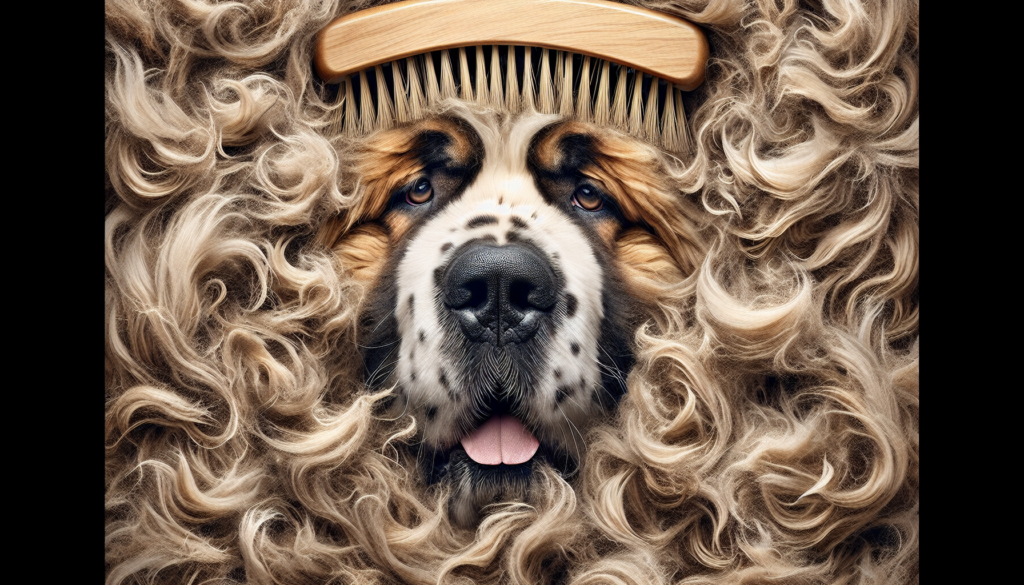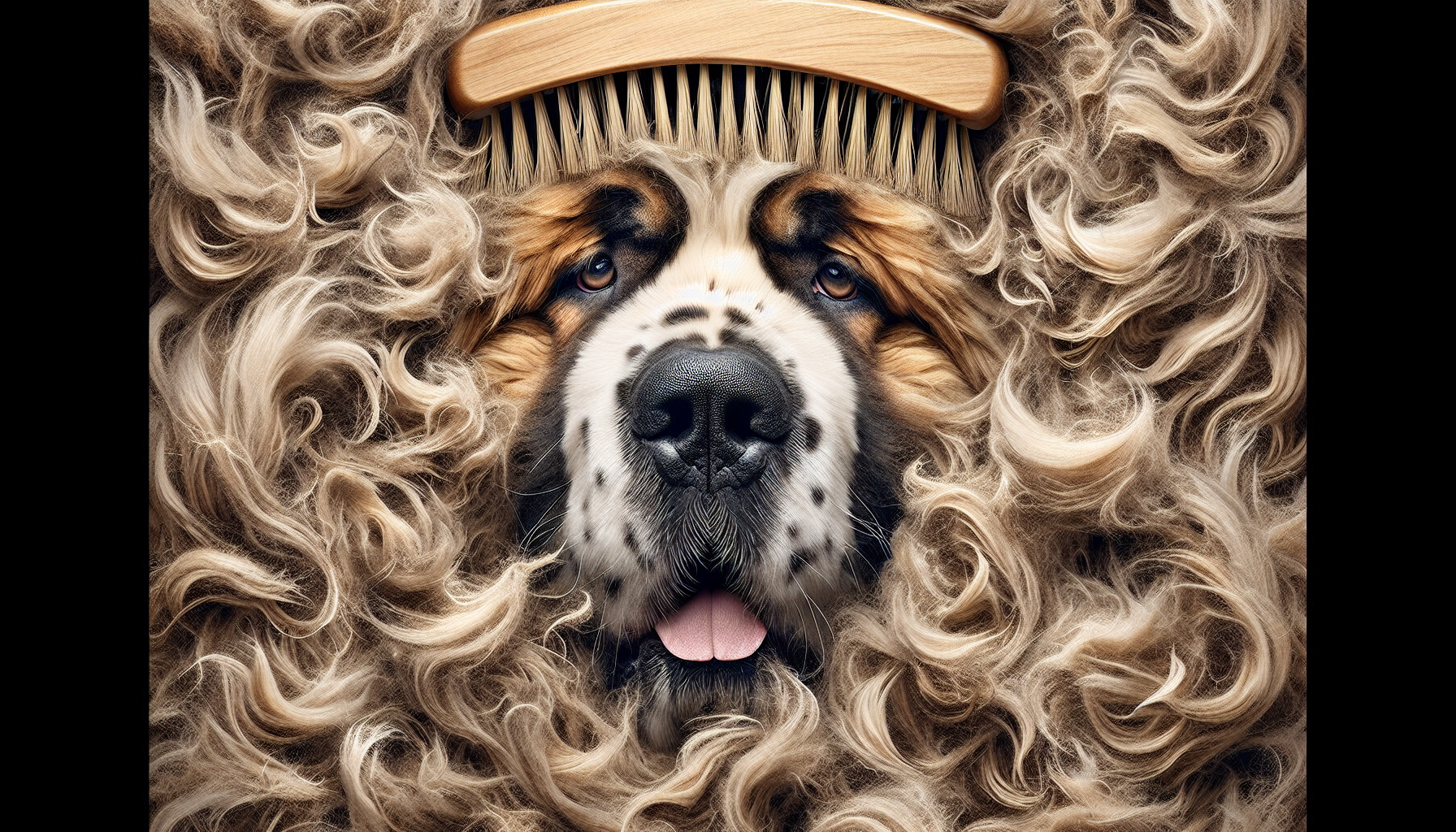Is your beloved Saint Bernard leaving a trail of fur wherever they go? If you find yourself constantly battling fur tumbleweeds and vacuuming up fluffy messes, you may be wondering why your gentle giant is shedding so much. Shedding is a natural process for dogs, but when it becomes excessive, it can be a cause for concern. In this article, we will explore some common reasons why Saint Bernards shed excessively and provide helpful tips to manage this furry situation. Get ready to say goodbye to those fluffy surprises and hello to a happier, healthier coat for your four-legged friend.

Possible Causes of Excessive Shedding in Saint Bernards
If you’ve ever found yourself wondering why your Saint Bernard is shedding so much, you’re not alone. Excessive shedding in these gentle giants can be a cause for concern, but it’s important to understand that there are several possible causes for this condition. In this article, we will explore the different factors that can contribute to excessive shedding in Saint Bernards and provide you with valuable insights on how to address this issue.
Seasonal Shedding
Natural Shedding Cycles
Saint Bernards, like many other dog breeds, have natural shedding cycles that are influenced by seasonal changes. During spring and fall, Saint Bernards tend to shed more heavily as they prepare for the warmer or cooler months respectively. This shedding allows them to maintain an appropriate body temperature and adjust to the changing weather conditions.
Increased Shedding in Warm Weather
One particular cause of excessive shedding in Saint Bernards is the onset of warmer weather. As the temperature rises, these dogs shed their dense winter coats in order to remain cool and comfortable. While it is entirely normal for them to shed during this time, it can sometimes be more challenging to manage the copious amount of loose hair they leave behind. Regular grooming and brushing play a vital role in managing shedding during these seasons.
Genetics
Inherited Traits
Another factor that contributes to excessive shedding in Saint Bernards is genetics. These dogs inherit their coat characteristics from their parents, and certain genetic traits can make them more prone to shedding. If you find that your Saint Bernard sheds excessively, it may be worth investigating their lineage to determine if this shedding trait runs in their family.
Puppies vs. Adult Dogs
It’s important to note that puppies and adult Saint Bernards may shed differently. Puppies typically shed their puppy coats as they grow into their adult coats, resulting in a temporary increase in shedding. The transition from a puppy coat to an adult coat can span several months, so it’s not unusual to see more hair being shed during this time. However, as they mature, their shedding patterns may normalize.
Poor Nutrition
Lack of Essential Nutrients
A lack of essential nutrients in their diet can also contribute to excessive shedding in Saint Bernards. Dogs, just like humans, require a balanced diet to maintain healthy skin and coat. If their diet is lacking in vital nutrients like omega-3 fatty acids, vitamins, and minerals, their coat quality may suffer, leading to increased shedding.
Low-Quality Dog Food
Low-quality dog food can be another culprit behind excessive shedding in Saint Bernards. It’s essential to provide your furry friend with a high-quality diet that meets their nutritional needs. A diet rich in protein, healthy fats, and a variety of vitamins and minerals can help improve their coat condition and minimize shedding.

Medical Conditions
Thyroid Problems
Thyroid problems such as hypothyroidism or hyperthyroidism can manifest in increased shedding in dogs. The thyroid gland plays a crucial role in regulating a dog’s metabolism, including their hair growth and shedding cycles. If your Saint Bernard is shedding excessively and showing other symptoms such as weight gain or loss, lethargy, or changes in appetite, it’s advisable to consult with your veterinarian to rule out any underlying thyroid issues.
Cushing’s Disease
Cushing’s disease, also known as hyperadrenocorticism, is another medical condition that can lead to excessive shedding in dogs. It occurs when the adrenal glands produce excessive amounts of cortisol, a stress hormone. Along with increased shedding, other common symptoms of Cushing’s disease include increased thirst and urination, a pot-bellied appearance, and muscle weakness. If you suspect your Saint Bernard may have Cushing’s disease, it is important to seek veterinary care for proper diagnosis and treatment.
Dermatitis
Dermatitis, or skin inflammation, can also be a contributing factor to excessive shedding in Saint Bernards. This condition can arise due to allergies, irritants, or infections. Symptoms of dermatitis include itching, redness, and irritation, which can lead to increased shedding. Identifying the underlying cause of dermatitis and working with your veterinarian to develop an appropriate treatment plan can help alleviate the shedding associated with this condition.
Allergies
Food Allergies
Allergies, whether food-related or environmental, can trigger excessive shedding in Saint Bernards. Food allergies occur when a dog’s immune system reacts adversely to certain ingredients in their diet. Common food allergens for dogs include beef, chicken, dairy, wheat, and soy. Allergies can manifest in various ways, including gastrointestinal issues, skin irritation, and increased shedding. If you suspect your Saint Bernard has a food allergy, consult with your veterinarian to determine the appropriate elimination diet or allergy testing.
Environmental Allergies
Just like humans, dogs can also develop allergies to environmental factors such as pollen, dust mites, or certain types of grass. These allergens can trigger allergic reactions in your Saint Bernard and lead to increased shedding. If you notice that your dog’s shedding is worse in certain environments or seasons, it’s possible that they have environmental allergies. Your veterinarian can help identify the specific allergens and recommend appropriate management strategies such as antihistamines or allergy shots.
Skin Infections
Bacterial Infections
Bacterial infections of the skin can cause excessive shedding in Saint Bernards. These infections often occur when the skin’s natural barriers are compromised, allowing bacteria to enter and multiply. Symptoms of a bacterial skin infection may include redness, swelling, sores, and excessive scratching or licking. If you suspect your Saint Bernard has a bacterial skin infection, consult with your veterinarian for proper diagnosis and treatment.
Fungal Infections
Fungal infections, such as ringworm, can also contribute to excessive shedding in Saint Bernards. These infections are caused by various types of fungi and can affect the skin, hair, and nails. Symptoms of a fungal infection may include circular patches of hair loss, redness, and itching. Prompt veterinary intervention is crucial to effectively treating and preventing the spread of fungal infections and managing shedding.
Parasites
Fleas and Ticks
Parasites, such as fleas and ticks, can cause significant discomfort and excessive shedding in Saint Bernards. These tiny pests feed on your dog’s blood and can lead to skin irritation, allergies, and hair loss. Regular prevention, such as using flea and tick treatments, is essential to protect your Saint Bernard from infestations and the associated shedding. If you notice signs of fleas or ticks on your dog, consult with your veterinarian for appropriate parasite control measures.
Mites
Mites, including sarcoptic and demodectic mites, can also be responsible for excessive shedding in dogs. These microscopic parasites can burrow into the skin and cause a range of skin problems, including itching, hair loss, and inflammation. Treatment options for mite infestations can vary, so it’s crucial to consult with your veterinarian for an accurate diagnosis and appropriate treatment plan to alleviate shedding caused by mites.
Stress or Anxiety
Environmental Stress
Stress and anxiety can manifest in various ways in dogs, and excessive shedding can be one of the symptoms. Changes in routine, loud noises, or unfamiliar environments can trigger stress responses in Saint Bernards. If you suspect that stress or anxiety is contributing to your dog’s excessive shedding, it’s important to provide them with a calm and secure environment. Creating a comfortable space for your dog, using calming techniques, and possibly incorporating behavior modification techniques can help reduce shedding associated with stress.
Separation Anxiety
Separation anxiety, a condition where dogs exhibit distress when separated from their owners, can also contribute to excessive shedding. The stress and anxiety that accompany separation can lead to increased shedding in Saint Bernards. If your dog displays signs of separation anxiety, such as destructive behavior, excessive barking, or inappropriate elimination, it’s important to seek professional help to address the underlying cause of their anxiety and manage their shedding effectively.
Lack of Grooming
Infrequent Brushing
Grooming plays a crucial role in managing shedding in Saint Bernards. Regular brushing helps remove loose hair and prevents it from accumulating around your home. When not brushed frequently, your dog’s loose hair can form mats and tangles, making shedding more noticeable and difficult to manage. Aim to brush your Saint Bernard at least once or twice a week, increasing the frequency during shedding seasons.
No Bathing or Drying
Bathing and drying are essential components of grooming that can help minimize shedding in Saint Bernards. Regular baths using dog-friendly shampoos and conditioners help maintain a clean and healthy coat, reducing the chances of skin issues that can contribute to shedding. Proper drying after bathing is equally important as excessive moisture can lead to skin infections and subsequent shedding. Ensure that you dry your dog thoroughly, paying particular attention to areas with dense hair.
In conclusion, excessive shedding in Saint Bernards can be attributed to several factors, including natural shedding cycles, genetics, poor nutrition, medical conditions, allergies, skin infections, parasites, stress or anxiety, and lack of grooming. By understanding the potential causes and taking appropriate steps to address them, you can minimize the shedding and help your Saint Bernard maintain a healthy coat. Regular veterinary care, a balanced diet, a grooming routine, and a loving, stress-free environment are key factors in managing excessive shedding and keeping your Saint Bernard looking and feeling their best.
